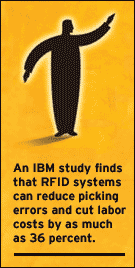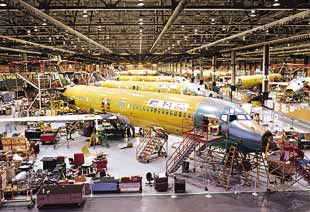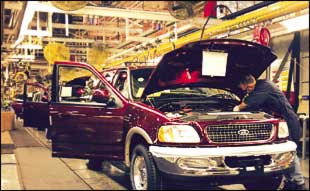If you’re struggling to develop a business case for deploying RFID technology and all you see are huge costs, you’re thinking too narrowly. RFID is a lot more than a technology that can improve order accuracy or reduce the amount of time spent scanning bar codes in the warehouse. As you wonder about the potential return on investment, keep in mind that RFID is a platform you can use to make your organization more efficient in many different ways in many different areas.
Think of the Internet. If you had tried to justify your investment in routers, switches and Ethernet cable by finding a return on investment from sending e-mail over the network, your company still wouldn’t be wired today. Yet the Internet makes almost every part of every business more efficient—from research and development to accounts receivable. And so it will be with RFID.
No company has RFID-enabled their operations from end to end. But many companies, including the five we profile here, have proved that lower costs and higher productivity can be achieved with RFID in key operational areas. That’s why it’s so critical to create a cross-functional team (see “A Mandate for Change,” page 18). Keep in mind that your company may not get the same benefits Boeing or Procter & Gamble got in one area, but you may achieve greater benefits in another. Each company has to find and focus on where it will get the most return on investment. See “Five More Ways to Save” on page 27 for additional ways to reap rewards from RFID.
Receiving. In June 2003, Boeing, the Chicago-based aircraft maker, went live with an RFID system in its commercial airplane unit in Wichita, Kan. The passive UHF system tracks parts as they are received into the facility. Boeing’s suppliers attach RFID tags to airplane parts before delivering them to the Wichita facility. The suppliers also send advance shipping notices over the Internet, which lets Boeing know the serial number associated with each part.
When Boeing receives the parts, their RFID tags are read automatically. The system matches the parts to the purchase order and confirms that the company got everything it ordered. Inventory is updated automatically. Boeing is still determining its precise return on investment, but it knows it’s saving in at least three ways: It doesn’t have to use people to scan parts into inventory; there are fewer mismatches between orders and deliveries to investigate; and it has a more accurate inventory.
Having suppliers put RFID tags on shipments can produce immediate benefits. A recent IBM Business Consulting Services study found that RFID could reduce labor spent on receiving by 60 to 90 percent. Keep in mind that the savings will be greater for manufacturers handling hundreds of different parts than for consumer packaged goods companies, which tend to buy bulk materials that are more easily tracked.
Manufacturing. Boeing employees used to scan bar codes on items as they entered or left shops that paint or chemically treat parts. When someone forgot to scan the bar code on a particular part, the company lost the ability to track it, and employees would have to go looking for it. Thanks to the RFID system it deployed, the company now knows exactly where parts are within the facility.
The system saves time and labor because people don’t have to scan bar codes and search the building for missing parts.
Boeing extended its parts-tracking system to its tool crib. Staff responding to a request for a specialized tool used to spend a lot of time searching the crib to see if it had been returned. Now tools are checked in and out automatically, and staff can look up instantly which tools are available. The system not only saves time and labor, it increases the utilization of tools.
Ford Motor Co. used to rely on bar codes or paper and pencil to track vehicles through the assembly process. The process was labor-intensive and prone to errors. So in 2000, Ford deployed a battery-powered RFID system from WhereNet, a Santa Clara, Calif.-based company that offers real-time locating technology, at its Michigan truck plant. The system, which Ford calls its Vehicle Inventory Management System, has been rolled out to all of Ford’s plants in North America. David Decker, Ford’s vehicle operations IT manager, says it has saved the company “tens of millions of dollars” since being deployed.
Ford places tags on vehicles early in the assembly process to track their progress through the final phases. Readers placed at various points in the assembly lines detect when a particular vehicle reaches a given location. The information is used, for example, to tell robots what color to paint a particular vehicle. Specific high-end models are automatically routed to areas of the assembly plant where special features can be added.
The automaker is also using WhereNet technology to track individual components, such as transmissions, so manufacturing personnel can locate them quickly. A container is affixed with a transmitting tag associated with the parts it holds, and every four minutes the tag transmits a signal to continually update its location. Decker says the system has improved the quality of Ford’s vehicles by ensuring that the right parts, options and features are applied to the right vehicles.
Consumer packaged goods companies don’t need to have expensive parts to track in order to benefit from RFID in their manufacturing operations. Read-write RFID tags can be placed on reusable containers that hold raw materials, such as flour or sugar. The date the material was placed in the container can be written to the tag so staff can quickly identify which material to use first. This system reduces waste because older goods are not left sitting in storage while recently received goods are used. RFID can also prevent employees from using the wrong material when, say, two different grades look exactly alike.
Warehouse management. In July, International Paper, a Stamford, Conn., manufacturer of paper, packaging and forest products, began operating one of the world’s first fully functional RFID-enabled warehouses at a mill in Texarkana, Texas. The system, which IP piloted at the warehouse for six months before launching for commercial use, covers all stocking, storage, movement and shipping of goods within the warehouse. For instance, it gives forklift operators real-time instructions about where rolls of paper are and where they need to be. If an operator picks up the wrong roll or puts a roll in the wrong place, the system alerts him to the mistake.
The RFID initiative has resulted in more accurate inventory tracking, elimination of lost products, reduced operating costs and decreased inventory, says Guillermo Gutierrez, smart packaging marketing manager for IP. Since the system can track where forklifts travel, the technology can be used to find the most cost-effective paths for specific tasks, creating further efficiencies.
Gutierrez declines to give a specific dollar figure on savings or other benefits but says its RFID products and operations are on target to meet IP’s goal of a more than 25 percent return on investment within three to five years. “The main benefit is inventory visibility and certainty,” he says.
CPG manufacturers have even bigger problems tracking items in their warehouses or distribution centers because they have many more stock-keeping units. Often items have to be tracked by lot number in case of a recall and because different lots have different expiration dates. This labor-intensive task can be virtually eliminated with automated RFID scanning at key choke points in the warehouse.
Picking and shipping. Picking products and building pallets of mixed goods can take up as much as half the time of warehouse employees, according to the IBM study. The process is prone to errors and usually requires verification before shipping. RFID systems can make it easier to find items within the warehouse, reduce errors in picking and cut labor costs by as much as 36 percent, the IBM study says.
Suppliers can reduce chargebacks and invoice deductions by working with retailers that automate receiving on their end. RFID tags on cases are scanned as they are being stacked on a pallet, and the inventory management system checks the pick against the purchase order from the retailer. When the shipment is ready, the supplier sends an advance shipping notice to the retailer with the serial numbers on the tag. The retailer confirms that it got everything on the ASN and that it matches the purchase order. Both sides waste less time investigating errors because shipments are checked against purchase orders and confirmed before they are shipped and when they arrive.
No supplier has fully RFID-enabled its picking system for pallets of consumer products, because tags have been too expensive. But in May 2002, Procter & Gamble deployed a 13.56 MHz RFID system from Escort Memory Systems to identify pallets coming off a production line at a plant in Spain. P&G planned to increase production at the facility but needed a way to avoid a bottleneck at the shipping dock. The answer: load pallets directly onto waiting trucks.
The challenge was to identify the right pallets and make sure they got on the correct trucks. Since the trucks went directly to stores, any errors would lead to unhappy customers. P&G used RFID readers on forklifts to scan tags embedded in the floor. That enabled the company to associate a forklift’s location with a pallet coming off the conveyor. When the forklift passed a tag at a dock door, the system confirmed that the pallet it was carrying belonged on the truck at that door.
The system, which cost under $100,000, allows P&G to load more pallets with one fewer forklift operator. And it eliminated errors because operators are alerted when a pallet is being loaded onto the wrong vehicle.
Yard management. Since April 2001, Associated Food Stores, a grocery distributor, has been using RFID to locate, track and manage trucks and shipping containers in real-time at its 600-acre facility in Farr West, Utah. The system from WhereNet is similar to the one used at Ford’s factories. All trailers are tagged when they arrive at the yard. RFID readers placed along the yard’s perimeter feed data to a software program that uses triangulation to tell dispatchers the trailer’s precise location. Based on that information, the dispatcher knows whether the trailer is being loaded, unloaded or repaired.
“Data accuracy is the most significant benefit we’ve experienced,” says Tim Van de Merwe, logistics manager at Associated Food Stores. “Before RFID, the processes we relied on to ensure accurate inventory of tractors, trailers and dollies on the yard were highly labor intensive.”
The system saves about $250,000 a year in labor, he says, because the company reallocated workers or eliminated positions. And Associated Foods was able to decrease the number of leased trailers it uses from 40 to five because the RFID system makes it possible to turn them around more quickly.
“Inventory is now automated, and we’re getting 100 percent accurate information,” Van de Merwe says. “Even when we were throwing labor at the [tracking] process, the best we ever got was 75 percent accuracy.”
Suppliers can benefit from coordinating warehouse management systems with yard management software so that pallets ready for delivery show up at a dock door at the same time that the truck does. This can lead to a smaller fleet size and fewer charges for late deliveries levied by retailers.
As you deploy RFID technology, look at all of the areas described above and see where the technology can provide the greatest benefits. But also plan to eventually integrate all of your systems. By doing so, you will create a whole new management platform. Senior executives will have an accurate, real-time view of what’s happening within your company. The information garnered will enable them to make decisions based on facts, not guesswork. And it should help to achieve efficiencies never before possible.
Procter & Gamble, for instance, expects to reduce its $3 billion in inventory to $2 billion by combining real-time information about its own operations with more timely data about sales from its retailer partners. If it can achieve this, P&G will free up $1 billion in working capital and cut inventory carrying costs by $200 million per year. That will offset most of the cost of the infrastructure and tags, and all the other savings will help bolster P&G’s bottom line.





